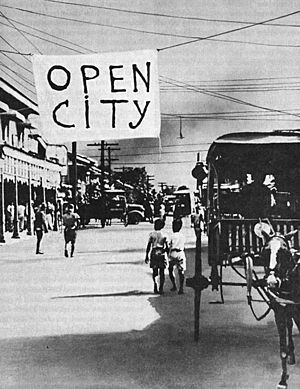Open city facts for kids

In war, when enemy forces are close to capturing a city, the government or military forces in control of the city will sometimes call the city an open city. This means that they will not try to defend the city. The attacking armies will be expected to not to bomb or attack the city. This approach aims to prevent historic landmarks from being destroyed and civilians from being killed.
No resistance
An open city is not defended and not fortified. It is open to occupation by opposing forces with no resistance by the defenders. Under International law an open city may not be bombed or subject to artillery attack.
Attacking forces do not always respect cities that call themselves an "open city." Defensive forces may use it as a political tactic as well. In some cases, the declaration of a city to be "open" is made by a side which is close to defeat. In other cases, the city could be defended but the defenders do not want the city to be destroyed.
World War II open cities
Several cities were declared open during World War II:
- Brussels in 1940
- Oslo in 1940
- Paris in 1940, from which the French Government fled after it became apparent that they could not defend it
- Belgrade in April 1941
- Penang in December 1941, after the British retreated to Singapore
- Manila in 1941, which the American military abandoned during the Japanese invasion.
- Rome on 14 August 1943, which the defending Italian forces declared unilaterally to be an "open city" following the cessation of Allied bombing. This applied when under attack by the Germans; subsequently Allied forces entered Rome in June 1944 and retreating German forces also declared Florence and Chieti on 24 March 1944 "open cities".
- Athens on 11 October 1944, which was declared an open city by the Germans.
Related pages
See also
 In Spanish: Ciudad abierta (Derecho) para niños
In Spanish: Ciudad abierta (Derecho) para niños

